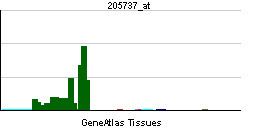Entrez 3785 | Ensembl n/a | |
 | ||
Aliases KCNQ2, BFNC, BFNS1, EBN, EBN1, EIEE7, ENB1, HNSPC, KCNA11, KV7.2, KVEBN1, potassium voltage-gated channel subfamily Q member 2 External IDs OMIM: 602235 MGI: 1309503 HomoloGene: 26174 GeneCards: KCNQ2 | ||
Kv7.2 (KvLQT2) is a potassium channel protein coded for by the gene KCNQ2.
It is associated with benign familial neonatal epilepsy.
The M channel is a slowly activating and deactivating potassium channel that plays a critical role in the regulation of neuronal excitability. The M channel is formed by the association of the protein encoded by this gene and a related protein encoded by the KCNQ3 gene, both integral membrane proteins. M channel currents are inhibited by M1 muscarinic acetylcholine receptors and activated by retigabine, a novel anti-convulsant drug. Defects in this gene are a cause of benign familial neonatal convulsions type 1 (BFNC), also known as epilepsy, benign neonatal type 1 (EBN1). At least five transcript variants encoding five different isoforms have been found for this gene.
